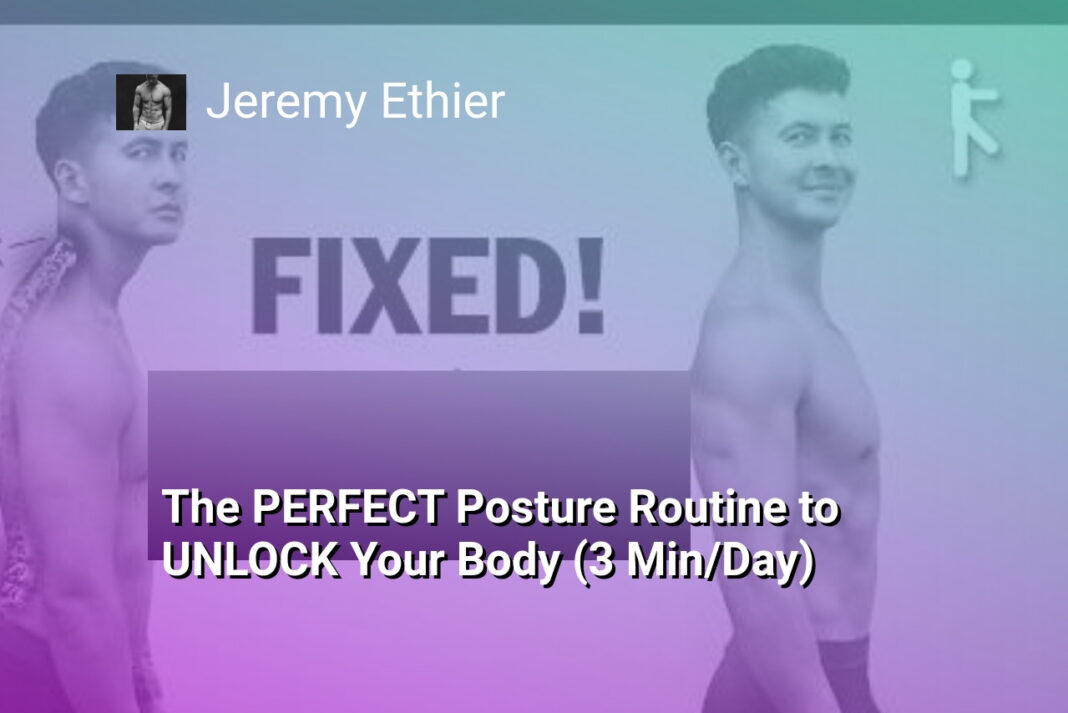The Bottom Line:
- The main theme of the text is how to reverse the effects of sitting for long periods of time and improve overall mobility and posture through a simple 3-minute daily exercise routine.
- The text discusses a study that found that using a neuromuscular electrical stimulator to contract the back muscles can help reverse the stiffness caused by prolonged sitting.
- The text outlines three exercises that target the shoulders, back/neck, and hips to improve range of motion and counteract the negative effects of sitting.
- The exercises are designed to be done in just a few minutes per day and can be gradually increased in intensity as the user becomes more comfortable with them.
- The text also mentions that there is an additional exercise that can be added to the routine to further improve posture and mobility, which is discussed in a linked video.
The Surprising Findings of a Sitting Study
Uncovering the Surprising Effects of Electrical Stimulation
Researchers conducted a fascinating study where participants were asked to sit for 4.5 hours to observe the impact on their muscle stiffness. The participants were divided into three groups: a control group, a group receiving low-level electrical stimulation, and a group receiving high-amplitude electrical stimulation.
The Surprising Findings
As expected, the control group and the low-level stimulation group experienced increased stiffness in their backs as the hours of sitting progressed. However, the real surprise came from the high-amplitude stimulation group. These participants, whose back muscles were actively contracting due to the electrical currents, experienced a near-complete reversal of the stiffness in their backs.
The Takeaway for Desk-Bound Individuals
The study’s findings suggest that simply moving and contracting the muscles that are underutilized during prolonged sitting can be an effective way to counteract the negative effects of a sedentary lifestyle. While electrical stimulation may not be a practical solution for most people, the researchers’ insights point to the importance of incorporating targeted exercises into one’s daily routine to maintain flexibility, improve posture, and enhance overall mobility.
The Wall Clock Exercise for Shoulder Mobility
Unlocking Shoulder Mobility with the Wall Clock Exercise
The wall clock exercise is a powerful tool for improving shoulder mobility and addressing the common issue of rounded, locked-up shoulders. This exercise not only loosens the deltoids and chest muscles but also strengthens the weakened muscles in the upper back and shoulders, leading to long-term posture improvements.
To perform the wall clock exercise, stand sideways with your fingertips touching the wall and your thumb pointing down. Engage your core, and without arching your back, slowly draw your palm in a big semicircle forward and up the wall. As you do so, allow your shoulder blade to move forward and then up. You should feel a stretch in your chest on the way up, as well as some of your shoulder and upper back muscles working.
Once you’ve completed the semicircle, reverse the motion, moving your arm back and down the wall, allowing your shoulder blade to move back and down. Repeat this cycle for about 30 seconds on each side.
The key to this exercise is finding the right level of stretch that feels comfortable for you. The closer you stand to the wall, the more challenging the exercise will be. Aim for a stretch that feels like a 4 or 5 out of 10 on the intensity scale, and avoid any movements that cause pain or discomfort.
By incorporating the wall clock exercise into your routine, you’ll be able to unlock your shoulder mobility, improve your posture, and set the stage for more effective workouts at the gym.
Activating the Back and Neck Muscles
When you’ve been sitting for a while and finally get up, the first stretch you often do is a simple back and neck extension. Your body is essentially telling you to wake up and use all those muscles in your back that have been on standby. However, there’s a more effective way to contract these muscles and completely reverse the sitting position, allowing them to go through their full range of motion.
Start by getting on all fours, with your hands directly under your shoulders. Engage your lats by spinning your elbows towards your thighs. Inhale and gently lift your tailbone towards the ceiling, reaching your chest forward through your biceps to stretch your abs. Squeeze your shoulder blades together as you lift your chin up towards the ceiling.
Next, exhale and imagine there’s a rope pulling your mid-back up towards the ceiling, rounding your spine as you push the floor away to open up your shoulder blades. Use your neck muscles to tuck your chin by looking towards your knees or even your belly button. You should feel a deep stretch in your back muscles, as well as your neck.
Spend about 30 seconds on this sequence, and then for the next 30 seconds, turn and look towards your left foot, which will stretch the muscles on the right side of your lower back and rib cage. Repeat the same motion on the other side, looking towards your right foot.
By incorporating these targeted back and neck exercises, you’ll be able to effectively reverse the effects of sitting and restore mobility to these crucial areas.
Improving Hip Mobility and Strength
The final piece of the 3-minute mobility routine is an exercise that targets the hips. When you’re sitting all day, your hips are essentially locked into one position, but they’re designed to move in all sorts of directions. This exercise moves the hips into various positions while strengthening the muscles that weaken from excessive sitting.
We’ll start with a level one version and then build up to a more advanced level three variation.
For level one, sit on the floor and bend one leg in front of your body at around a 90-degree angle. Do the same with the back leg, using your hands for support if needed. Sit up tall, positioning your shoulders square to the front of your shin. Exhale as you reach your chest forward, hinging over your front leg until you feel a deep stretch on the outside of your front leg’s hip or glute area. Avoid rounding your spine and focus on bending at the hip. Inhale as you come back to the starting position, and repeat for 30 seconds on each side.
In level two, you’ll maintain the same 90-degree leg position, but this time, as you lean forward, push your front shin down into the ground and lift your hips up to get your torso upright. You should feel some of your glute muscles working, and the hip flexors and groin muscles of your back leg stretching. Reverse the motion by lowering as slowly as you can while leaning forward. Aim for 30 seconds on each side.
For level three, you’ll repeat the level two movement, but instead of sticking to one side at a time, you’ll windshield wiper your knees directly over to the other side on the way down, and then repeat the motion back. Reach your arms out in front of you and engage your core during the transition, using your hands for support if needed.
By incorporating these progressive hip exercises, you’ll be able to restore mobility and strength to this crucial area, further enhancing the benefits of the overall 3-minute mobility routine.
The Back and Neck Stretching Sequence
Unlocking Your Spine and Neck
When you’ve been sitting for an extended period, the first thing you likely do when you get up is stretch your back and neck. Your body is essentially telling you to wake up and use those muscles that have been dormant. However, there’s a better way to contract them, completely reverse the sitting position, and guide them through their full range of motion.
Start by getting on all fours with your hands directly under your shoulders. Engage your lats by rotating your elbows towards your thighs. Inhale and gently lift your tailbone towards the ceiling, reaching your chest forward through your biceps to stretch your abs. Squeeze your shoulder blades together as you lift your chin up towards the ceiling. This is the first half of the exercise.
Now, exhale and imagine a rope pulling your mid-back up towards the ceiling, rounding your spine. Push the floor away to open up your shoulder blades, then use your neck muscles to tuck your chin by looking towards your knees or even your belly button. You should feel a deep stretch in your back muscles as well as your neck. Repeat this for about 30 seconds.
For the next 30 seconds, we’ll move your spine in a way you probably don’t do all day. Come back to a neutral position and turn and look towards your left foot. This will stretch the muscles on the right side of your lower back and rib cage. Return to center, then repeat on the other side, looking towards your right foot.
Mobilizing Your Hips
The perfect 3-minute mobility routine wouldn’t be complete without an exercise to target the hips. When you’re sitting all day, your hips are literally locked into one position, but they’re designed to move in all sorts of directions. We need an exercise that moves them into as many different positions as possible while strengthening the muscles that weaken from sitting too much.
Start with the level one version. Sit on the floor and bend one leg in front of your body at around a 90° angle, then do the same with the back one. You can use your hands for support if needed. Sit up tall and try to position your shoulders square to the front of your shin. Keep your spine tall and exhale as you reach your chest forward, hinging over your front leg until you feel a deep stretch on the outside of your front leg’s hip or glute area. Inhale as you come back to the starting position and exhale as you get into your next rep. Do 30 seconds on each side, trying to get deeper into the stretch with each rep.
For level two, maintain that same 90° leg position, but this time as you lean forward, push your front shin down into the ground and lift your hips up to get your torso upright. You should feel some of your glute muscles working, and you should feel the hip flexors and groin muscles of your back leg stretching. Once you get to the top, reverse this by lowering as slowly as you can while leaning forward. Aim for 30 seconds on each side.
Finally, for level three, repeat what we did in level two, but instead of sticking to just one side at a time, you’re going to “windshield wiper” your knees directly over to the other side on the way down, and repeat this motion back and forth. Reach your arms out in front of you and engage your core during the transition. You can always use your hands for support here if you need it.
The Hip-Targeting Exercise in 3 Levels
Unlocking Your Hips: A Gradual Approach
The final exercise in this routine focuses on the hips, which can become locked in place from prolonged sitting. This exercise aims to move the hips through a variety of positions while strengthening the often-neglected muscles.
Level 1: Foundational Hip Stretch
Start by sitting on the floor with one leg bent in front of you at a 90-degree angle, and the other leg in the same position behind you. You can use your hands for support if needed. Sit up tall, keeping your shoulders square to the front of your shin. Exhale as you reach your chest forward, hinging at the hips to feel a deep stretch on the outside of your front leg’s hip or glute area. Avoid rounding your spine. Inhale as you return to the starting position. Repeat for 30 seconds on each side, trying to deepen the stretch with each repetition.
Level 2: Activating the Hip Muscles
Maintain the same 90-degree leg position, but this time as you lean forward, push your front shin down into the ground and lift your hips up to get your torso upright. You should feel your glute muscles working, and the hip flexors and groin muscles of your back leg stretching. Slowly lower back down, leaning forward again. Aim for 30 seconds on each side.
Level 3: Windshield Wiper Variation
For the most challenging version, repeat the Level 2 movement, but instead of sticking to one side, windshield wiper your knees directly over to the other side on the way down, and repeat the motion back and forth. Reach your arms out in front of you and engage your core during the transitions. You can still use your hands for support if needed. This variation provides a deeper stretch in your groin and hip flexors.
Remember, these exercises are designed to gradually improve your hip mobility and strength. Start with the Level 1 version and work your way up as you become more comfortable with the movements. Consistent practice is key to unlocking your full range of motion and relieving the effects of prolonged sitting.
The Crucial Underrated Exercise for Posture and Fat Burning
Unlocking Your Mobility: The Key to Posture and Fat Burning
The secret to reversing the detrimental effects of prolonged sitting lies in a simple yet powerful exercise that often goes overlooked. While the previous exercises targeted specific areas like the shoulders, back, and hips, this underrated movement can provide a comprehensive solution to improve your overall posture, mobility, and even fat-burning capabilities.
The Transformative Power of Planks
The humble plank exercise may seem like a basic core workout, but its benefits extend far beyond just strengthening your abdominal muscles. When executed correctly, the plank can have a profound impact on your posture, flexibility, and metabolic efficiency.
Unlocking the Full-Body Benefits
By holding a proper plank position, you engage a multitude of muscle groups, from your core and shoulders to your glutes and legs. This full-body activation not only improves your overall strength and stability but also helps to counteract the imbalances and tightness that often arise from prolonged sitting.
As you maintain the plank, your body is forced to work against gravity, activating the muscles that support your spine and keep your posture aligned. This, in turn, can lead to improved spinal alignment, reduced back pain, and a more upright, confident stance.
Moreover, the isometric nature of the plank exercise challenges your muscular endurance, which can translate to enhanced fat-burning capabilities. By engaging multiple muscle groups simultaneously, the plank elevates your heart rate and metabolic rate, allowing you to burn more calories even during periods of rest.
So, if you’re looking to take your posture and overall fitness to the next level, be sure to incorporate the plank exercise into your routine. Start with shorter durations and gradually work your way up, aiming for a minimum of 60 seconds per set. Consistent practice will not only improve your mobility but also help you achieve a leaner, more toned physique.





